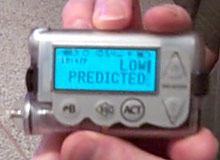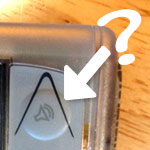Revel Continuous Glucose Monitor Alert Volume – Can it be Adjusted?

After eating sugar tabs, I let the Low Predicted alerts continue in order to hear the Paradigm 523's alarm.
A few days ago I received my first “Low Predicted” alert from my new Medtronic Revel Paradigm 523 Insulin Pump and Continuous Glucose Monitor. My wife and I had been eagerly awaiting this moment so that we could hear what the Medtronic rep had described as a “siren”. After 10 minutes of not-so-loud alerts had passed, the device was supposed to begin alarming. Instead of canceling the Low Predicted alert, I ate a couple sugar tabs and grabbed our Flip video camera so that we could document the sound of the alarm. After all, we would be relying on the Revel’s alerts and alarms to wake us up to help avoid unexpected nighttime bouts of hypoglycemia. Given the events from 4 weeks ago, the continuous glucose monitor’s alerts and alarms could be the answer to our prayers…or so we thought.


What purpose does the Paradigm 523's speaker symbol serve, if not to control the volume?
As you can hear (or can’t hear) in the video above, the Revel’s CGM alarm is in no way a “siren” as the Medtronic rep had described. Has he actually ever heard the alarm, or was he just trying to sell us on the device? Sure, the fact that the alarm sound alternates with vibration helps (though it would be better if it alarmed and vibrated at the same time), but it still doesn’t make up for the alarm’s lack of an adequate decibel level. After all, if you smell smoke you don’t whisper, “Fire,” you scream it at the top of your lungs, “FIRE!!!!” or in this case, “CHECK YOUR BLOOD GLUCOSE NOW!!!!”
Despite my Medtronic instructor telling me that my Revel Insulin Pump and Continuous Glucose Monitor’s alert and alarm volume levels could not be adjusted (other than adjusting the length of the the beep for the alert), I naturally began to wonder if this was truly the case. After all, there is a speaker symbol printed on the device’s UP arrow button (see image). Why is that there, if not to manipulate the volume in some way? I decided to ask her again, this time emphasizing my frustration with the volume level. Below is our email correspondence:
Ellen,
The alert and alarm volume on the Revel is frustratingly low (we let the predictive alerts go once so that we could hear the alarm). Once or twice I’ve even kept sleeping through the alerts and my wife has had to wake me. Is there any way to adjust this? I can see a speaker symbol on the “up” button, so I assume it’s doable. The only reason I can think that Medtronic prohibited volume control is because they currently have no way of preventing people from turning the volume all the way down, or they have yet to fully refine the integration of the CGM into the pump. This definitely seems to be the device’s biggest flaw at the moment. I do hear the alerts when I’m in my office, but I’m awake and there is no background noise. However, even watching TV I have missed one or two and if, for instance, I was skiing, I doubt I would hear them at all under my jacket on the slopes.
-Kevin
Ellen’s response:
Hi Kevin, I understand your frustration. In Utilities under Alarm, Alert Type the loudest it will go is Long Beep. If people can’t hear that then I tell them to switch to vibrate so since the pump is on their body they will feel the vibrate instead of not hearing the alarms. Let me know how that works.
thanks
I had already set the Alert Type to “Long Beep” before I first started using the device, but for the most part that just changes the length of the beep, not the volume. It seems that with a device such as a continuous glucose monitor, where the alerts and alarms could potentially save your life, not being able to adjust the volume is a serious oversight. After all, the ringer volume on my iPhone can be adjusted to a much louder level.





 My name is Kevin Lang and I am a Type 1 Diabetic who was diagnosed in May of 2004 at the age of 27. My last A1C was 6.0 in May 2015. I used to use daily shots of Lantus and Novolog to control my blood sugar until I switched to the MiniMed Paradigm Revel Insulin Pump in February 2011. To learn more about me, follow the about link in the menu bar.
My name is Kevin Lang and I am a Type 1 Diabetic who was diagnosed in May of 2004 at the age of 27. My last A1C was 6.0 in May 2015. I used to use daily shots of Lantus and Novolog to control my blood sugar until I switched to the MiniMed Paradigm Revel Insulin Pump in February 2011. To learn more about me, follow the about link in the menu bar.
I am in the decision process right now and need to decide about getting the CGM module before I place my order for this pump. I don’t have insurance so the additional cost of over $1000, not to mention the monthly cost of supplies for it – $250+ is a big consideration. Sounds to me from your post that it might not be worth the investment.Just the pump might be the wisest move right now. What do you think?
Beverly, I cannot give you advice on whether to use a continuous glucose monitor or not. Obviously, using a CGM is a personal decision that should be made by you in consultation with your doctor. For me, it is worth it because it could potentially save my life, or in the least alert me to a coming low blood sugar. It has also been a big help to see the peaks in the daily graphs of my blood sugar. For example, analyzing the online reports has been a big help in seeing what foods are causing my BS to spike the most, in addition to noticing that my BS has been spiking quite a bit when I wake up.
Sure, there are certain cons to the model I own, like the volume, but it does have a vibrate option that I have yet to try. I’m going to get longer pump infusion set tubing as well (mine is currently the 23in, but they offer 32in and 43in), so if my infusion set is attached to my abdomen I can clip the pump to the side of my pillow. This should hopefully help a lot in hearing the alerts. I haven’t had too much trouble hearing them during the day and my CGM has already helped me to avoid more than one oncoming low BS. For me, so far this has in part been a matter of setting the low and predictive alerts correctly.
My advice would be to obviously educate yourself as much as possible before you make your decision about a CGM. Did your doctor set up a demo for you with a CGM rep? It’s a great opportunity to ask questions.
My hubby has the revel with CGM and we love it. We wouldn’t live a day without it now. I agree though, the alarm are not loud enough!!
Sadly this is a MAJOR problem with the Medtronic CGM. If you Google it you’ll find lots of frustration. It was particularly frustrating that the original Guardian truly had siren alarms – mine woke people sleeping in the next room as well as me! The switch to the 522 was a big disappointment, although the rest of the device had improved immeasurably.
There are two potential solutions to the problem. One is to buy a Dexcom (I’ve recently switched after 4 and a half years with Medtronic), and the alarms are much better. I realise this is not a very practical solution for most though! The alternative is to use a wireless radio microphone to amplify the sound at night – again Google is a good source of info on this – and stick with vibrate during the day. I wish that reps would realise that wearing it close to your body can be a pain when you also want it easily accessible to monitor the trends!
Oh, and the speaker button is for the audio bolus.
I keep my pump clipped to my pajama bottoms at night, and while I don’t hear the alarms, I definitely feel the vibrations. And since I live alone, that’s VERY important! I don’t know about the x23 models, but my 722 vibrates if I don’t respond to the alarm or siren.
I’ve used the DexCom (System Seven Plus) since May of 2009. My GF and I have noted that I’ve become inured to the hypo alarm while asleep. The DexCom also has no volume adjustment (although I cannot compare it’s volume with the Medtronic). DexCom tech support suggested (with a strong “…this isn’t something we officially recommed…”) putting the receiver in a water glass on the bedside table. This *does* amplify both the vibrate and beep sounds. Worth a try, methinks!
James, that’s interesting because my wife and I actually thought of putting the pump inside of a tin can, figuring the CGM alarm vibration might cause a loud rattle. For now, I’ve been going with 32-inch infusion set tubing, which provides just enough length for me to use my belt clip and attach the pump to the side of my pillow. That way it’s about as close to my ears as it’s going to get short of me sleeping on top of it. Even still, like you I also manage to sleep right through the alarms. It’s funny, being able to sleep through annoying noises used to be a good thing, not anymore.
I opted to keep my dexcom seven plus when going to the medtronic pump. the volume was a big factor. Moreover, the non connected design lets me sit it in a metal dish, or, i’ve thought for us seriously deep sleepers set it on the bedside table with a mike plugged into my load clock radio….
dirk, I had thought of the microphone idea to amplify the sound. It would be kind of like watching nature shows when you can actually hear the ants walking along (okay, maybe it’s not that bad), but like you said, my Medtronic pump/CGM is tethered to me and if I sat it on the bedside table, I would surely end up yanking it onto the floor during the night. Ouch. Here’s a hopeful sign for the future of CGMs – http://www.mevsdiabetes.com/c8-medisensors-cgm-noninvasive/
I even bought a hearing aid, but that has not solved the problem of the weak sound made by the 523. With the aging population, Medtronics needs to pay attention to this problem.
I haven’t ordered one yet, but it looks like Medtronic has released a new product that might help to amplify the alarms a bit. It’s actually a remote monitor called mySentry that, according to Metronic, “Alarms and alerts sound loudly to awaken deep sleepers, and the volume can be adjusted to your desired level.” It’s really supposed to be a way for parents to monitor a child’s blood sugar through the night, but I imagine we could just use it in the same way and keep it next to the bed. Here’s a link that explains more about it: http://www.medtronicdiabetes.com/products/mysentry